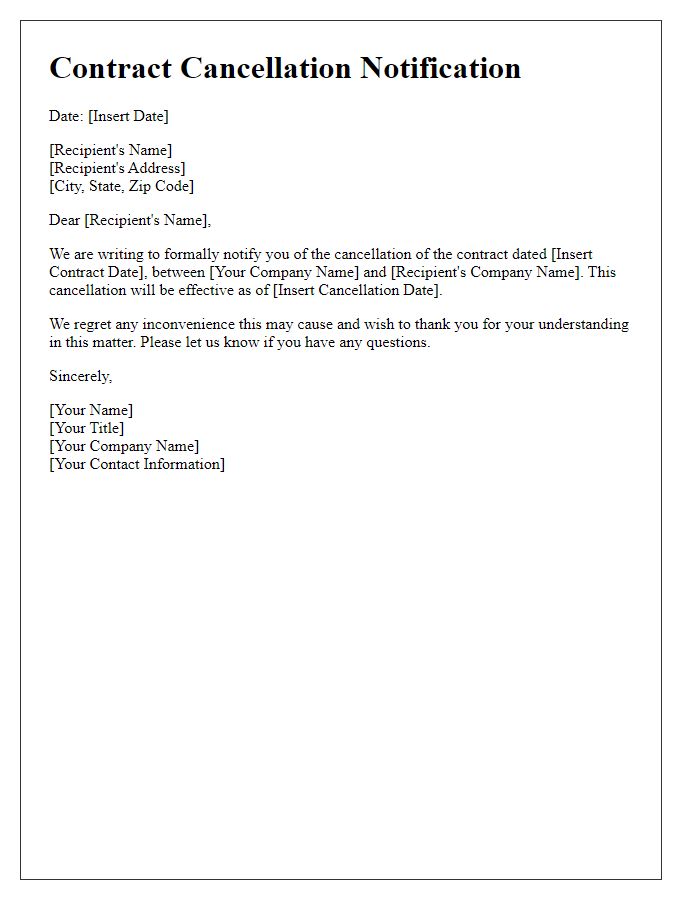When it comes to navigating the complex waters of contract rescission, it's important to communicate effectively and clearly. Whether you're a business owner looking to dissolve a partnership or an individual needing to back out of an agreement, a well-crafted letter can make all the difference. In this article, we'll guide you through the essential components of a contract rescission notice to ensure your intentions are properly conveyed. Let's dive in and explore how to write a letter that captures your needs while maintaining professionalismâread on to find out more!

Clear statement of rescission intention
A contract rescission notice serves as a formal communication that declares the intention to void a legally binding agreement. This document must clearly articulate the desire to retract consent to the contract, which could involve various elements, such as the date of the original contract signing, the parties involved (for instance, a seller and a buyer), and the specific reasons for the rescission (like a breach of contract, misrepresentation, or mutual consent). Including pertinent details, such as identifying contract numbers or associated terms, can bolster the clarity and enforcement of the rescission notice. The written notification should be delivered through a method ensuring receipt (like certified mail) to confirm that the other party is aware of the rescission intentions. The documentation may also specify any associated obligations or settlement terms that need to be addressed following the contract nullification.
Reference to the original contract
Contract rescission involves the formal cancellation of a contract due to various reasons, such as breach of terms or mutual agreement. During this process, it's crucial to reference the original contract number (e.g., Contract #12345, dated January 1, 2023) to provide clarity and ensure proper identification. This notice should clearly outline the specific reasons for rescission, such as failure to meet deadlines or deliverables, and explicitly state the effective date of cancellation (e.g., effective immediately upon receipt of this notice). Additionally, documentation of any prior discussions or agreements related to the rescission can enhance understanding and transparency of the process.
Legal grounds for rescission
Contract rescission refers to the legal process of canceling a contract, often due to specific grounds that invalidate the agreement. Common legal grounds for rescission include misrepresentation, fraud, undue influence, duress, and a lack of capacity. Misrepresentation occurs when one party provides false information, leading the other to enter the contract under false pretenses. Fraud takes place when deceit is intentional, aiming to secure an unfair advantage. Undue influence involves one party exerting excessive pressure on another, compromising their ability to make a free decision. Duress refers to instances where a party is forced into an agreement under threats of harm or coercion. A lack of capacity might involve individuals who are minors, mentally incapacitated, or intoxicated, lacking the legal ability to enter a contract.
Return of consideration or obligations
A contract rescission notice serves as a formal notification to terminate a contract due to various reasons, such as a breach or mutual agreement. This document outlines the requirements for the return of any consideration exchanged, such as money or services, immediately following the notice. Each party involved--typically the rescinding party and the counterparty--must fulfill their obligations defined in the original contract to ensure a fair return of assets. Additionally, specific details such as the contract date, parties' names, and a clear description of the obligations to be returned are essential for legal clarity. It is advisable to document the process thoroughly to provide evidence of compliance and agreement from both parties, fostering an amicable resolution.
Contact details for further communication
For a contract rescission notice, be sure to include essential elements for clear communication. The contact details at the end should specify a name, relevant position, company name, and complete address. Include a phone number and email for quick reachability. For example, John Smith, Contract Manager, ABC Corporation, 123 Business Ave, New York, NY 10001, Phone: (555) 123-4567, Email: john.smith@abccorp.com. Providing detailed contact information ensures prompt responses and facilitates further discussions regarding the contract termination process.













Comments